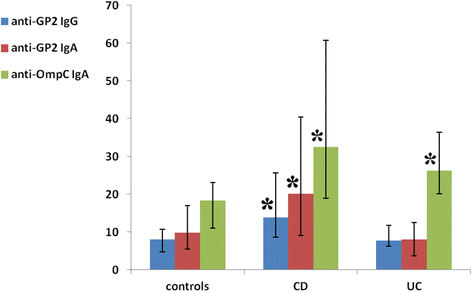Anti-Outer membrane protein C and anti-glycoprotein 2 antibodies in inflammatory bowel disease and their association with complicated forms of Crohn's disease
- PMID: 25551469
- PMCID: PMC4296537
- DOI: 10.1186/s12876-014-0190-1
Anti-Outer membrane protein C and anti-glycoprotein 2 antibodies in inflammatory bowel disease and their association with complicated forms of Crohn's disease
Abstract
Background: Precise diagnostics of inflammatory bowel disease (IBD) and identification of potentially more aggressive phenotypes of Crohn's disease (CD) is urgently needed. The aim of our prospective study was to assess the relationship between serum anti-OmpC IgA (Outer membrane protein C), anti-GP2 (anti-glycoprotein 2) IgG and anti-GP2 IgA antibodies with IBD and their association with complicated forms of CD.
Methods: The study included 86 patients with CD, 25 patients with UC and 45 controls, blood donors. In CD group, 24/86 (28%) had B1 phenotype, 20/86 (23%) B2, 13/86 (15%) B3 and 29/86 (34%) B2 + B3. L1 involvement was present in 13/86 (15%), L2 in 13/86 (15%), L3 in 60/86 (70%). Serum anti-OmpC IgA, anti-GP2 IgG and IgA antibodies were investigated by means of ELISA. The data obtained were tested statistically by means of descriptive statistics, non-paired t-test, Mann-Whitney rank sum test, Spearman rank order correlation and Pearson product moment correlation using SigmaStat software.
Results: Anti-OmpC IgA were noted to be significantly higher in CD (median 32.6, inter-quartile range (IQR) 18.9-60.7) compared to the controls (median 18.3, IQR 11.1-23.1), p < 0.001. Anti-GP2 IgG were significantly higher in CD (median 13.9, IQR 8.6-25.6) compared to the controls (median 8.0, IQR 4.7-10.8), p < 0.001. Anti-GP2 IgA were significantly higher in CD (median 20.1, IQR 9.1-40.4) compared to the controls (median 9.8, IQR 5.6-16.9), p < 0.001. Significant difference was found in anti-OmpC IgA between UC (median 26.2, IQR 20.2-36.4) and the controls (median 18.3, IQR 11.1-23.1), p < 0.001. In CD anti-OmpC IgA were significantly higher in B2 compared to B1: p = 0.041 and in B2 + B3 compared to B1: p = 0.036. Anti-GP2 IgA were significantly higher in B2 + B3 compared to B1: p = 0.009 and in B3 compared to B1: p = 0.029. In CD there was a significant difference in anti-OmpC IgA between patients with surgery and without surgery, p = 0.005.
Conclusions: We have confirmed association between anti-OmpC IgA and IBD (CD and UC) and an association between anti-GP2 (IgG and IgA) and CD. Patients with complicated forms of CD have significantly higher levels of anti-OmpC IgA and anti-GP2 IgA.
Figures
References
-
- Silverberg MS, Satsangi J, Ahmad T, Arnott ID, Bernstein CN, Brant SR, Caprilli R, Colombel JF, Gasche C, Geboes K, Jewell DP, Karban A, Loftus EV, Jr, Peña AS, Riddell RH, Sachar DB, Schreiber S, Steinhart AH, Targan SR, Vermeire S, Warren BF. Toward an integrated clinical, molecular and serological classification of inflammatory bowel disease: report of a Working Party of the 2005 Montreal World Congress of Gastroenterology. Can J Gastroenterol. 2005;19(Suppl A):5A–36A. - PubMed
-
- Odes S, Vardi H, Friger M, Wolters F, Hoie O, Moum B, Bernklev T, Yona H, Russel M, Munkholm P, Langholz E, Riis L, Politi P, Bondini P, Tsianos E, Katsanos K, Clofent J, Vermeire S, Freitas J, Mouzas I, Limonard C, O’Morain C, Monteiro E, Fornaciari G, Vatn M, Stockbrugger R, European Collaborative Study Group on Inflammatory Bowel Disease Effect of phenotype on health care costs in Crohn’s disease: a European study using the Montreal classification. J Crohns Colitis. 2007;1:87–96. doi: 10.1016/j.crohns.2007.08.004. - DOI - PubMed
Publication types
MeSH terms
Substances
LinkOut - more resources
Full Text Sources
Other Literature Sources
Medical
Miscellaneous


